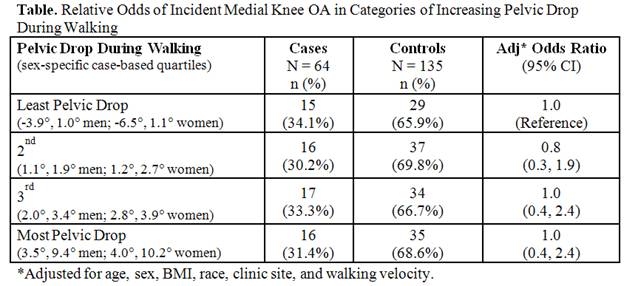Session Information
Session Type: Combined Abstract Sessions
Background/Purpose:
During walking, the contralateral pelvis tends to drop as the weight bearing limb enters midstance. If excessive, pelvic drop (PD) can result in increased loading of the medial knee. We previously reported an increased prevalence of medial knee OA in persons with greater PD, but while some rehabilitation strategies target reduction of PD in hopes of preventing knee OA onset, it is not yet known whether PD is actually a cause or a consequence of medial knee disease. The purpose of this longitudinal case-control study was to assess the causal relation of PD to 2-year risk of incident medial knee OA. We also determined the effect of trunk lean on this relationship.
Methods:
The Multicenter Osteoarthritis Study (MOST) consists of middle aged and older adults living in Iowa or Alabama that have or are at risk of knee OA. Among knees with no medial OA at the 60-month exam, readers identified incident cases at 84 months as having Kellgren & Lawrence grade ≥ 2 with medial > lateral joint space narrowing (0-3 scale) on fixed flexion knee x-ray (kappa > 0.80). Two control knees per case were randomly selected (1 per subject), and cases and controls underwent video assessment of PD during walking at the 60-month visit. Using synchronized frontal and sagittal cameras (60 Hz) and surface markers on the anterior superior iliac spines (ASISs), a physical therapist measured mean PD and mean trunk lean during the midstance phase of a mid-trial step over two self-paced walking trials. PD was measured as the frontal angle between the horizontal and a line joining left and right ASIS markers (ICC= 0.93), while trunk lean was measured as the frontal angle between the horizontal and a line joining left and right acromion processes (ICC= 0.98). Quartiles of PD were formed using the sex-specific distribution among cases, and logistic regression estimated the relative odds of incident medial knee OA in each quartile while controlling for covariates. Analysis was repeated within strata of ipsilateral (≤ -0.1°), neutral (0.0° to 6.4°), and contralateral (≥ 6.5°) trunk lean.
Results:
199 subjects contributed 64 case and 135 control knees. Mean +/- sd age, BMI, and walking speed was 66.8 +/- 8.3 yrs, 29.4 +/- 5.0 kg/m2, and 1.18 +/- 0.17 m/sec, respectively. 60.3% were female, 85.4% were white, and 48.2% were seen in Alabama. Mean +/- sd PD was slightly greater in women, but comparable among case and control knees (2.5° +/- 2.6° vs. 2.3° +/- 2.8°, p= 0.66). Relative odds of incident medial knee OA did not change across PD quartiles (p trend = 0.89), and trunk lean did not modify the results (p = 0.92).
Conclusion:
These findings do not confirm a longitudinal association between pelvic drop during walking and 2-year risk of incident medial knee OA. Previous reports of a cross-sectional association could indicate that pelvic drop is a frequent consequence of existing medial knee OA rather than an antecedent cause of incident knee disease.
Disclosure:
K. D. Gross,
None;
E. K. Quinn,
None;
M. C. Nevitt,
None;
J. C. Torner,
None;
C. E. Lewis,
None;
D. T. Felson,
None.
« Back to 2014 ACR/ARHP Annual Meeting
ACR Meeting Abstracts - https://acrabstracts.org/abstract/relation-of-pelvic-drop-during-walking-to-risk-of-incident-medial-knee-osteoarthritis-the-multicenter-osteoarthritis-study/

